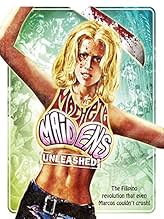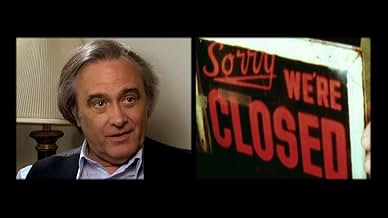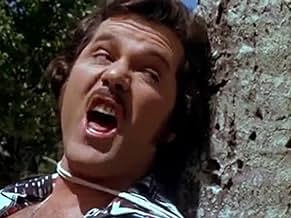VALUTAZIONE IMDb
7,3/10
1847
LA TUA VALUTAZIONE
Aggiungi una trama nella tua linguaA fast moving odyssey into the subterranean world of the rarely explored province of Filipino genre filmmaking.A fast moving odyssey into the subterranean world of the rarely explored province of Filipino genre filmmaking.A fast moving odyssey into the subterranean world of the rarely explored province of Filipino genre filmmaking.
Gerardo de Leon
- Self - Director
- (filmato d'archivio)
Recensioni in evidenza
This was a an absolutely brilliant documentary on the history of film making back in the 70s and 80s in the Philippines.
Why the Philippines? Because it was cheap....very cheap and pretty much no rules with what you could do.
Most of the movies made then were b grade or grindhouse made for the drive ins. Though one big budget classic was made there ..... Apocalypse Now.
This documentary was made by the same people who made Not Quite Hollywood and Electric Boogaloo -The Wild, Untold Story Of Canno Films...both of witch are brilliant documentaries as well.
Great insights from Roger Corman, Pam Grier, John Landis, Joe Dante, R. Lee Emery Sid Haig, Chris Mitchum etc.
If you love 70s, 80s B movies this documentary is a must see!!!
Why the Philippines? Because it was cheap....very cheap and pretty much no rules with what you could do.
Most of the movies made then were b grade or grindhouse made for the drive ins. Though one big budget classic was made there ..... Apocalypse Now.
This documentary was made by the same people who made Not Quite Hollywood and Electric Boogaloo -The Wild, Untold Story Of Canno Films...both of witch are brilliant documentaries as well.
Great insights from Roger Corman, Pam Grier, John Landis, Joe Dante, R. Lee Emery Sid Haig, Chris Mitchum etc.
If you love 70s, 80s B movies this documentary is a must see!!!
This documentary with it's (deliberately?) misleading title, gives viewers a brief overview of the Filipino cult cinema of the sixties, seventies and eighties. In a seemingly endless string of fragmented interviews (some of the edits so short that the subject's title is flashed for a fleeting moment), the film tries to draw an overview of this period of American/Filipino co-productions. Archival footage is interspersed here and there, and occasionally we are given context.
Is it interesting? Yes, but as much as it is frustrating. For you will certainly find that the film never settles down from its opening moments. The pace of the film is that of one tempo, as if the editor was worried that we might lose interest, or as if the visual information was paramount and the factual information (something I'm more interested in than anecdotal) was a mere triviality. You will be bombarded with cuts and clips and cues for the duration of the film - it's an editing style borne from the free-to-air TV realm that transposes to the cinema with a terrible effect.
Also, the relentless funk soundtrack (the staple to the C-Grade Grindhouse films) undermined the interviewees' comments, robbing them of any memorable moment and washing them altogether with the same colour. I can't help but relate the style of this documentary with American style 20-to-1 type shows, where the interviewees are there to provide colour to a proposed topic, not to provide any real insight. This is the films worst crime, for Filipino film-makers we are shown are outnumbered five-to-one by the Americans, yet the tiny grabs we are given with these eccentric characters were far more interesting and exotic.
This film belongs on a commercial or pay TV network, but the limited audience and scope of the film will probably condemn it to the Australian Broadcasting Corporation's schedule sometime in the near future. Wait for it then, for the cinema gives little to this difficult documentary.
Is it interesting? Yes, but as much as it is frustrating. For you will certainly find that the film never settles down from its opening moments. The pace of the film is that of one tempo, as if the editor was worried that we might lose interest, or as if the visual information was paramount and the factual information (something I'm more interested in than anecdotal) was a mere triviality. You will be bombarded with cuts and clips and cues for the duration of the film - it's an editing style borne from the free-to-air TV realm that transposes to the cinema with a terrible effect.
Also, the relentless funk soundtrack (the staple to the C-Grade Grindhouse films) undermined the interviewees' comments, robbing them of any memorable moment and washing them altogether with the same colour. I can't help but relate the style of this documentary with American style 20-to-1 type shows, where the interviewees are there to provide colour to a proposed topic, not to provide any real insight. This is the films worst crime, for Filipino film-makers we are shown are outnumbered five-to-one by the Americans, yet the tiny grabs we are given with these eccentric characters were far more interesting and exotic.
This film belongs on a commercial or pay TV network, but the limited audience and scope of the film will probably condemn it to the Australian Broadcasting Corporation's schedule sometime in the near future. Wait for it then, for the cinema gives little to this difficult documentary.
This is a very entertaining look at a specific time and place in the history of exploitation film-making. It documents the rather strange scenario where the Philippines became a hotbed of psychotronic cinema production between the 60's and early 80's. While I haven't seen more than two or three films that were made under these conditions, it didn't stop the film from being interesting and entertaining. In fact, like many similar documentaries Machete Maidens Unleashed! is most probably a lot more enjoyable than the films it features. Instead we get many, many clips from these crazy films, so it's difficult to get bored.
The films themselves range from the schlock horror of the 60's, via the women-in-prison flicks of the 70's to the martial arts action films of the 80's. It takes the form of the talking heads format where many of the participants tell us about their experiences working in the field. And perhaps unsurprisingly very different rules applied in the Philippines. There's a lot of humour in the presentation. No one is under any illusions about the seriousness of the movies, yet you will no doubt come away from this and have two or three new films you want to seek out. And I suppose with all that in mind, Machete Maidens Unleashed! has done its job.
The films themselves range from the schlock horror of the 60's, via the women-in-prison flicks of the 70's to the martial arts action films of the 80's. It takes the form of the talking heads format where many of the participants tell us about their experiences working in the field. And perhaps unsurprisingly very different rules applied in the Philippines. There's a lot of humour in the presentation. No one is under any illusions about the seriousness of the movies, yet you will no doubt come away from this and have two or three new films you want to seek out. And I suppose with all that in mind, Machete Maidens Unleashed! has done its job.
I watched a couple of women-in-prison movies the other day. Both were made in the Philippines. This documentary goes behind the scenes to show why and how Roger Corman type films were made there. Cheap actors and lax safety rules made for an ideal situation for making low budget films.
Blood, breasts, and beasts were the staples of films like Mad Doctor of Blood Island, Beast of Blood, The Big Doll House, Women in Cages, Black mama, White Mama,The Big Bird Cage, and the classic Vampire Hookers.
We see stars like Pam Grier learning the craft in these cheap films. Part of a new wave of women as action heroes, which was new to moviegoers.
The documentary was invaluable in understanding the background of filmmaking.
Blood, breasts, and beasts were the staples of films like Mad Doctor of Blood Island, Beast of Blood, The Big Doll House, Women in Cages, Black mama, White Mama,The Big Bird Cage, and the classic Vampire Hookers.
We see stars like Pam Grier learning the craft in these cheap films. Part of a new wave of women as action heroes, which was new to moviegoers.
The documentary was invaluable in understanding the background of filmmaking.
Machete Maidens Unleashed! (2010)
*** 1/2 (out of 4)
Entertaining documentary from Mark Harley discusses the making of countless exploitation films that were shot in the Phillippines. If you read up on the movie is really makes you think that it focuses in on those Phillipean exploitation movies but you're quickly going to realize that it's mainly about American productions that were shot there because producers could get such deals with rights, equipment and of course the jungle locations. Many famous faces like Joe Dante, Roger Corman, Dick Miller, John Landis, Sid Haig and Jack Hill are joined by some faces people haven't seen on screen for thirty-plus years (since they appeared in these movies). For the most part this is an incredibly entertaining film because the director does a great job at mixing in all the film clips with the countless comments being made. By the two-minute mark I actually had to pause the film so that I could get a pen and paper and keep track of some of the amazing clips that were being shown. Naturally, those who appreciate this type of cheap trash are the ones who are going to be the most entertained because once you've seen one of these pictures you're certainly not going to forget it and hearing some of the stories about the making of them are just priceless. Haig tells a hilarious bit about if you're in a strip club after midnight the owner would just lock you in (due to a law) and you'd have to stay there and party all night. Landis talks about the certain type of tolerance you had to have for these films. Many actresses who appeared nude in these films talk about how it made them feel powerful. Eddie Romero is the main focus from the actual Phillipean filmmakers and we get a few comments from him as well. Fans of exploitation are certainly going to enjoy seeing so many faces they recognize and this is certainly a great place to start if you're needing title recommendations.
*** 1/2 (out of 4)
Entertaining documentary from Mark Harley discusses the making of countless exploitation films that were shot in the Phillippines. If you read up on the movie is really makes you think that it focuses in on those Phillipean exploitation movies but you're quickly going to realize that it's mainly about American productions that were shot there because producers could get such deals with rights, equipment and of course the jungle locations. Many famous faces like Joe Dante, Roger Corman, Dick Miller, John Landis, Sid Haig and Jack Hill are joined by some faces people haven't seen on screen for thirty-plus years (since they appeared in these movies). For the most part this is an incredibly entertaining film because the director does a great job at mixing in all the film clips with the countless comments being made. By the two-minute mark I actually had to pause the film so that I could get a pen and paper and keep track of some of the amazing clips that were being shown. Naturally, those who appreciate this type of cheap trash are the ones who are going to be the most entertained because once you've seen one of these pictures you're certainly not going to forget it and hearing some of the stories about the making of them are just priceless. Haig tells a hilarious bit about if you're in a strip club after midnight the owner would just lock you in (due to a law) and you'd have to stay there and party all night. Landis talks about the certain type of tolerance you had to have for these films. Many actresses who appeared nude in these films talk about how it made them feel powerful. Eddie Romero is the main focus from the actual Phillipean filmmakers and we get a few comments from him as well. Fans of exploitation are certainly going to enjoy seeing so many faces they recognize and this is certainly a great place to start if you're needing title recommendations.
Lo sapevi?
- QuizAll the footage of Quentin Tarantino interviewing Cirio H. Santiago had to be cut from the final finished version of the film.
- ConnessioniFeatured in Kain's Quest: The Arena (2017)
- Colonne sonoreLet's Go Where the Action Is
Written and Performed by Tommy Boyce and Bobby Hart
I più visti
Accedi per valutare e creare un elenco di titoli salvati per ottenere consigli personalizzati
- How long is Machete Maidens Unleashed!?Powered by Alexa
Dettagli
- Data di uscita
- Paese di origine
- Siti ufficiali
- Lingua
- Celebre anche come
- Девки с мачете на свободе!
- Luoghi delle riprese
- Aziende produttrici
- Vedi altri crediti dell’azienda su IMDbPro
- Tempo di esecuzione1 ora 24 minuti
- Colore
- Proporzioni
- 1.78 : 1
Contribuisci a questa pagina
Suggerisci una modifica o aggiungi i contenuti mancanti

Divario superiore
What is the Spanish language plot outline for Machete Maidens Unleashed! (2010)?
Rispondi






























